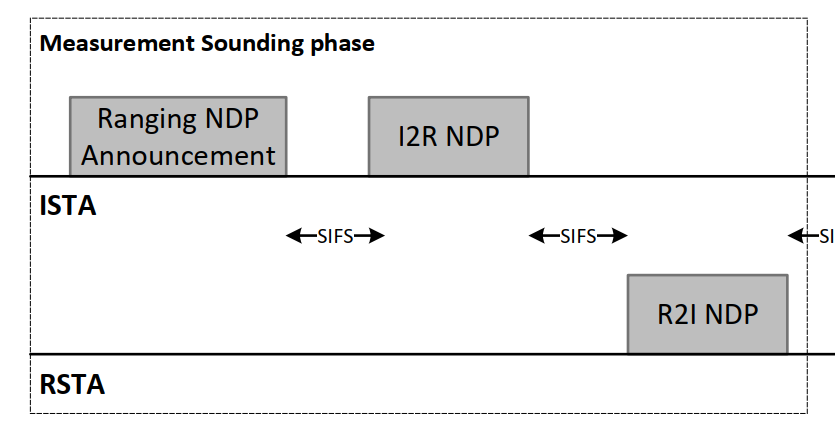Thank you Cheng for the response. Precedence in 802.11az (which I am not familiar with) is definitely a factor. Those who are involved with 802.11az understand this much better than me. However, in addition to the points I raised earlier,
there is also the complexity that some NDP frames are “dummy” in the sense that the STA/AP that receives it should ignore and not carry out CSI measurement. Maybe this (and other points I raised) are acceptable/better rather than changing the paradigm for
TF-sounding.
thanks and regards
-Anirud
Anirudha (Anirud) Sahoo (He/Him)
https://sites.google.com/view/a-sahoo
National Institute of Standards and Technology
Wireless Networks Division
Communications Technology Lab
100 Bureau Drive, Stop 6730
Gaithersburg, MD 20899
Ph: 301-975-4439
From: Chen, Cheng <cheng.chen@xxxxxxxxx>
Sent: Friday, March 18, 2022 5:47 PM
To: Sahoo, Anirudha (Fed) <anirudha.sahoo@xxxxxxxx>; STDS-802-11-TGBF@xxxxxxxxxxxxxxxxx
Subject: RE: question about Non-TB sensing
Hi Anirud,
---So, the spec says this fact should be configured (or coded) in the NDPA frame. Is this easy to do? I am guessing that it would involve the MLME (at the AP) to extract/decode that information from the NDPA frame and then configure
its PHY to send only one LTF symbol while transmitting R2I NDP. Similar problem when the non-AP STA is only sensing receiver.
This is already possible and similar protocol is already defined in 11az spec. In 11az, the non-AP STA can send a Ranging NDPA and configure the parameters (NSTS, Number of LTF symbols etc.) for both the I2R NDP and R2I NDP.


Best,
Cheng
From: Sahoo, Anirudha (Fed) <00001823ca88828f-dmarc-request@xxxxxxxxxxxxxxxxx>
Sent: Friday, March 18, 2022 2:40 PM
To: STDS-802-11-TGBF@xxxxxxxxxxxxxxxxx
Subject: [STDS-802-11-TGBF] question about Non-TB sensing
Hi all,
In the D.01 PDT document, for Non-TB sensing measurement instance (Fig. 11.41f), If the non-AP STA initiator is only sensing transmitter, then R2I NDP is an overhead. Hence, the draft says the R2I NDP should be transmitted with minimum
possible length with one LTF symbol. So, the spec says this fact should be configured (or coded) in the NDPA frame. Is this easy to do? I am guessing that it would involve the MLME (at the AP) to extract/decode that information from the NDPA frame and then
configure its PHY to send only one LTF symbol while transmitting R2I NDP. Similar problem when the non-AP STA is only sensing receiver.
Instead, can we use TF-sounding for this purpose? That is, if the non-AP STA is only transmitter, then it sends “regular” NDPA and then I2R NDP and the AP does not send R2I NDP. If the non-AP STA is only receiver, then it sends a TF-sounding
trigger frame to the AP and then waits for the AP to send R2I NDP (no I2R NDP in this case). Of course, if the non-AP STA is both transmitter and receiver then it has to do both the sequences (this case has more overhead than the current protocol in D.01).
So, in this solution there is no need for a “special” NDP (with one LTF symbol).
Of course, the above proposed solution throws the concept of TB into a spin, i.e., currently TB is only used when AP is the sensing initiator. With the proposed solution, non-AP STA uses “part” of the TB sensing paradigm: only the TF-sounding
concept.
Would love to hear thoughts of other members. My apologies if this is too late to discuss.
thanks and regards
-Anirud
Anirudha (Anirud) Sahoo (He/Him)
https://sites.google.com/view/a-sahoo
National Institute of Standards and Technology
Wireless Networks Division
Communications Technology Lab
100 Bureau Drive, Stop 6730
Gaithersburg, MD 20899
Ph: 301-975-4439
To unsubscribe from the STDS-802-11-TGBF list, click the following link:
https://listserv.ieee.org/cgi-bin/wa?SUBED1=STDS-802-11-TGBF&A=1
To unsubscribe from the STDS-802-11-TGBF list, click the following link: https://listserv.ieee.org/cgi-bin/wa?SUBED1=STDS-802-11-TGBF&A=1